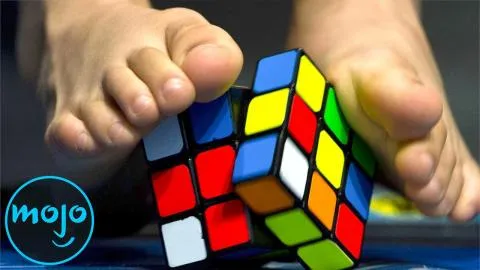5 Amazing Rubik's Cube Facts

For this list, we're breaking down the unbelievable trivia that leaves us more baffled than the cube behind it all. We're basing our picks on a mix of shocking data, unusual stories and how the cube is still relevant today.
#5: It Is the World’s Most Recognized Puzzle
With an estimated 3.5 billion dollars spent on Rubik's Cubes worldwide, it's become an instantly identifiable puzzle. Though the cube has become a popular puzzle/toy, inventor Ernő Rubik actually designed the cube as a visual tool for geometry. After showing it off at the 1979 Nuremberg Toy Fair, Rubik's invention took off, selling over 350 million copies to date. A huge success in the eighties, the toy was popular enough to spawn its own TV show at the time. The cube has become so recognizable that movies often use it as a shorthand for intelligence. It's appearance in 'The Pursuit of Happyness' even gave it a resurgence in sales back in 2006.
#4: It Took the Inventor a Month to Solve it
Though Ernő Rubik was an architect and professor, the puzzle he invented didn't come to him naturally. After scrambling his own cube, Rubik famously said that he had created a code that he couldn't read. Taking over a month to research and work on a solution, Rubik eventually solved the cube through his scientific approach. Rubik found the corners first, slowly creating a set of rules to figure the puzzle out. Despite his satisfaction after finishing the puzzle, Rubik has admitted he knew there were better ways to solve it. Rubik is no speed-cuber today either, only managing a solve in around one minute.
#3: Cube Lube
Devoted fans of the toy are always racing for a faster time, and have built a competitive yet supportive community of "cubers." After extended use your cube is going to get pretty stiff, making it impossible to solve quickly. Instead of replacing the puzzle, many cubers use lube to keep their cubes turning smoothly. Rubik's even sells their own lubricant for half the price of a cube, comparing their competitors' lube to tar. The company also provides a full instructional video to show you how to apply it. Cubers even debate over the ideal lubricant for the toy based on the frictions each style of lube reduces. Talk about an enthusiastic niche community!
#2: The WCA-Approved World Record for Solving it Is 3.47 Seconds
With so many cubers trying to perfect their technique, there are always a few people “gleaming the cube”. Once staggering, Ronald Brinkman's 1982 record of 19 seconds now looks slow by contemporary standards. In 2017, Patrick Ponce solved the cube in a blinding 4.69 seconds only to be dethroned by SeungBeom Cho with a time of 4.59 seconds. However, they were both beaten the next year at the Wuhu Open 2018 in Novemberwhen Yusheng Duachieved a result more than a second faster than the latter. With his 3.47 seconds - approved by the World Cube Association - he also beat Feliks Zemdegs’ May score of 4.22 seconds at the Cube for Cambodia 2018. These aren’t the only Rubik’s Cube-related records though. As of 2019, the one-handed record is 6.88 seconds, and the feet-only record is 16.96 seconds. Max Hilliard holds the record for the fastest blindfolded solve, with a swift 15.5 seconds. No human holds a candle to robots however: in 2016, one solved a cube in 0.637 seconds - but in 2019, two MIT students improved a robot such that it solved the puzzle in 0.38 seconds!
#1: 43 Quintillion Possibilities
With six sides and nine squares per side, the possible combinations of colors exceeds 43 quintillion. To be precise, it’s actually 43 quintillion, 252 quadrillion, 3 trillion, 274 billion, 489 million and 856 thousand permutations of the cube. At 2.244 inches a cube, you could cover the earth in 273 layers of uniquely scrambled cubes. End to end they run over 1.24 quintillion miles long, or roughly 261 light-years. Even if you managed a different permutation every second it would take you 1.4 trillion years to make every possible combo. Interestingly enough, regardless of all the possible mixes, any cube can be solved in 20 moves or less.
